SmartFish
“Perfection is achieved, not when there is nothing more to add, but when there is nothing left to take away.” Antoine de Saint-Exupery
The objective of team SmartFish is to sell or license this revolutionary general aviation aircraft technology to the aviation industry.
The SmartFish technology, which is highly innovative in terms of safety, economy and emotion, can be used for a wide range of applications, from UAV to high performance sports planes to business jets that can accommodate up to 20 passengers. Please check the News section for the latest updates.

Smart Fish’s USPs are as follows:
Economy
Long range cruise speed of Mach 0.85
Long range of Proof Of Concept POC with 3'500-4000km
Ultra long range variant of SmartFish with range of up to 10'000km
Low fuel consumption
Low CO2 emissions
Huge internal volume and therefore a roomy cabin
Lower manufacturing cost compared to conventional design due to lower part count
Lower operating and maintenance cost than conventional designs
Safety
Reduced moving parts/simplified rudder control
Stall almost impossible, due to the fact that AOA’s of 40 degrees or more can be flown
Simple maintenance
High crashworthiness
Emotional
Fun to fly
Easy to operate
Beautiful design
High marketing potential
SmartFish differs from conventional aircraft by its innovative aerodynamic design, while relying on standard technologies for building materials and propulsion.


Backed through results from preliminary wind tunnel tests and scale model flight data we are convinced that a SmartFish aircraft has many potential advantages over conventional aircraft of comparable size and propulsion system, such as improved efficiency (per freight transported) and a much bigger internal volume. Because of the simplicity of the design we anticipate that manufacturing costs (for design and assembly), maintenance costs, and operating costs will be potentially lower than those for conventional aircraft.
The SmartFish proof of concept will be realized in collaboration with following companies: Extra (world leader in aerobatic aircraft) for system integration and test flights, Leichtwerk for interpretation statics and dynamics, LTB Borowski for composite manufacturing, Liebherr Aerospace for Landing Gear System development, DLR (German Aerospace Center) for flutter analysis and inlet optimization, RUAG Aerospace for wind tunnel testing, and EPFL, the Swiss Federal Institute of Technology for verification of different simulation results.
last site update: 22.6.2011
